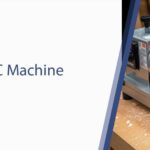In today’s hyper-competitive manufacturing environment, every minute of downtime costs money.
For CNC machining operations, unplanned downtime can cost manufacturers between $22,000 to $50,000 per hour.
But what if you could predict failures before they happen and control your machines from anywhere in the world?
Remote monitoring and control technology has revolutionized how manufacturers approach CNC operations, delivering measurable results that directly impact the bottom line.
This comprehensive guide reveals how industry leaders are using remote CNC monitoring to slash downtime, boost efficiency, and stay competitive in 2025.
The Hidden Cost of CNC Downtime (And Why It’s Getting Worse)
Breaking Down the Real Impact
CNC downtime isn’t just about stopped production – it’s a cascade of costs that many manufacturers underestimate:
Immediate Financial Impact:
- Lost production: $22,000-$50,000 per hour for typical CNC operations
- Labor costs: Technicians standing idle during repairs
- Rush orders: Premium shipping costs to meet delayed deadlines
- Customer penalties: Late delivery fees and contract violations
Long-term Business Consequences:
- Customer trust erosion: 67% of manufacturers report losing clients due to delivery delays
- Competitive disadvantage: Rivals capture market share during your downtime
- Reputation damage: Industry word-of-mouth travels fast
Common CNC Downtime Culprits
Understanding failure patterns is crucial for prevention:
- Tool wear and breakage (35% of downtime incidents)
- Mechanical component failures (28% of incidents)
- Control system malfunctions (18% of incidents)
- Human error during setup (12% of incidents)
- Power and environmental issues (7% of incidents)
Game-Changer: IoT-Powered Remote CNC Monitoring
The Technology Revolution
Modern CNC remote monitoring leverages Internet of Things (IoT) sensors to transform your machines into intelligent, connected assets.
Here’s how it works:
Smart Sensor Integration:
- Vibration sensors: Detect bearing wear and spindle issues
- Temperature monitors: Track motor and coolant temperatures
- Current sensors: Monitor power consumption patterns
- Acoustic sensors: Identify unusual machine sounds
- Position encoders: Verify axis accuracy and performance
Real-Time Data Collection: Every sensor continuously streams data to cloud-based analytics platforms, creating a comprehensive digital twin of your CNC operation.
Immediate Benefits You’ll Experience
Week 1-2: Basic Monitoring
- Real-time machine status visibility
- Instant alerts for critical issues
- Remote access to machine diagnostics
Month 1-3: Pattern Recognition
- Historical trend analysis
- Performance benchmarking
- Initial predictive insights
Month 3+: Full Optimization
- Accurate failure prediction
- Optimized maintenance scheduling
- Maximum uptime achievement
Predictive Maintenance: Your Crystal Ball for CNC Health
From Reactive to Proactive
Traditional maintenance operates on two flawed models:
- Reactive: Fix it when it breaks (expensive and disruptive)
- Scheduled: Replace parts on fixed intervals (wasteful and unreliable)
Predictive maintenance uses machine data to determine the optimal time for maintenance – maximizing component life while preventing failures.
Real-World Predictive Maintenance Success
Case Study: Automotive Parts Manufacturer
- Before: 12 unplanned downtime events per month
- After: 2 unplanned events per month (83% reduction)
- ROI: $340,000 annual savings from reduced downtime
- Implementation time: 6 weeks
Key Predictive Indicators to Monitor
- Vibration Analysis
- Bearing deterioration patterns
- Spindle imbalance detection
- Resonance frequency changes
- Thermal Signatures
- Motor overheating trends
- Coolant system efficiency
- Electrical connection integrity
- Power Consumption Patterns
- Motor efficiency degradation
- Cutting load variations
- System power anomalies
Smart Alerts: Your 24/7 CNC Guardian
Beyond Basic Notifications
Modern remote monitoring systems deliver intelligent, contextual alerts that help you make informed decisions quickly.
Multi-Channel Alert System:
- Critical alerts: SMS + phone call for immediate attention
- Warning alerts: Email + dashboard notification
- Information alerts: Dashboard logging for trend analysis
Smart Alert Features:
- Escalation protocols: Automatic escalation if initial alerts aren’t acknowledged
- Context-rich notifications: Include relevant data, trends, and recommended actions
- Priority filtering: Reduce alert fatigue by focusing on truly important issues
Customizable Alert Scenarios
Production-Critical Alerts:
- Spindle temperature exceeds safe operating range
- Tool wear approaching replacement threshold
- Coolant level drops below minimum
Efficiency Alerts:
- Machine idle time exceeds normal parameters
- Cycle time increasing beyond acceptable range
- Quality metrics trending downward
Maintenance Alerts:
- Predictive maintenance window approaching
- Component replacement recommended
- Calibration schedule due
Remote Control: Operate CNC Machines from Anywhere
Secure Remote Access Capabilities
Modern remote control systems provide secure, encrypted access to CNC machine functions:
Machine Control Functions:
- Parameter adjustment: Modify speeds, feeds, and tool paths remotely
- Program loading: Upload new part programs without shop floor presence
- Machine start/stop: Control production cycles with proper safety protocols
- Tool management: Monitor tool life and schedule changes
Safety and Security Measures:
- Multi-factor authentication: Ensure only authorized personnel access systems
- Encrypted communications: Protect data transmission with military-grade encryption
- Audit trails: Complete logging of all remote actions and users
- Emergency stop protocols: Immediate shutdown capabilities for safety situations
Practical Remote Control Applications
Setup Optimization: Reduce setup time by 40% through remote parameter adjustment and program verification before arriving on-site.
Multi-Site Management: Operate and monitor CNC machines across multiple facilities from a central command center.
Expert Support: Enable remote troubleshooting by equipment specialists without travel costs or delays.
Bulletproof Security for Connected CNC Systems
Addressing Cybersecurity Concerns
As CNC systems become more connected, security becomes paramount.
Leading manufacturers implement multi-layered security approaches:
Network Security:
- VPN access: Secure tunneling for remote connections
- Firewall protection: Industrial-grade network security
- Network segmentation: Isolate CNC systems from general IT networks
Data Protection:
- End-to-end encryption: Protect data in transit and at rest
- Regular security updates: Automated patching and security enhancements
- Backup protocols: Secure data backup and recovery procedures
Access Control:
- Role-based permissions: Limit access based on job functions
- Time-based access: Restrict access to specific time periods
- Geographic restrictions: Limit access to approved locations
Integration Excellence: Connecting Every System
ERP and Production System Integration
Maximum efficiency comes from connecting remote monitoring systems with existing business systems:
Enterprise Resource Planning (ERP) Integration:
- Production scheduling: Optimize schedules based on real-time machine availability
- Inventory management: Trigger tool and material orders based on usage data
- Cost accounting: Accurate job costing using actual machine runtime data
Manufacturing Execution System (MES) Integration:
- Work order tracking: Real-time job progress monitoring
- Quality data collection: Integrate quality metrics with production data
- Traceability: Complete part history and manufacturing genealogy
Benefits of Integrated Systems:
- Unified dashboard: Single view of all manufacturing operations
- Automated workflows: Reduce manual data entry and processing
- Data-driven decisions: Comprehensive analytics across all systems
Popular Integration Platforms
Leading ERP Systems:
- SAP Manufacturing
- Oracle NetSuite
- Microsoft Dynamics 365
- Epicor ERP
MES Solutions:
- GE Digital Proficy
- Siemens Opcenter
- Wonderware MES
- Rockwell FactoryTalk
Measuring Success: ROI and KPIs That Matter
Key Performance Indicators (KPIs)
Track these critical metrics to measure remote monitoring success:
Downtime Metrics:
- Mean Time Between Failures (MTBF): Track improvement over time
- Mean Time to Repair (MTTR): Monitor reduction in repair time
- Overall Equipment Effectiveness (OEE): Measure overall improvement
Cost Metrics:
- Maintenance cost per machine hour: Track reduction over time
- Emergency repair costs: Monitor decrease in unplanned repairs
- Labor efficiency: Measure maintenance team productivity gains
Quality Metrics:
- First-pass yield: Improved consistency through better monitoring
- Scrap rate reduction: Early problem detection reduces waste
- Customer satisfaction scores: Improved delivery performance
Expected ROI Timeline
Month 1-3: Foundation Building
- Initial system setup and training
- Basic monitoring and alerting active
- Initial reduction in unplanned downtime
Month 4-6: Optimization Phase
- Predictive models becoming accurate
- Significant reduction in unplanned downtime
- Improved maintenance efficiency
Month 7-12: Full Maturity
- Maximum reduction in unplanned downtime
- Substantial reduction in maintenance costs
- Notable improvement in overall productivity
Typical ROI: Strong positive return within first year
Implementation Roadmap: Your Path to Success
Phase 1: Assessment and Planning (Week 1-2)
Current State Analysis:
- Audit existing CNC machines and control systems
- Identify downtime patterns and cost impacts
- Evaluate network infrastructure capabilities
- Define success metrics and goals
Solution Design:
- Select appropriate monitoring hardware and software
- Plan network architecture and security measures
- Design integration touchpoints with existing systems
- Create implementation timeline and budget
Phase 2: Pilot Implementation (Week 3-6)
Start Small, Think Big:
- Select 2-3 critical machines for initial deployment
- Install sensors and monitoring systems
- Configure basic alerts and dashboards
- Train key personnel on system operation
Early Wins:
- Document immediate improvements in visibility
- Capture initial downtime reduction benefits
- Gather user feedback for system optimization
- Build internal support for full deployment
Phase 3: Full Deployment (Week 7-16)
Systematic Rollout:
- Expand to remaining CNC machines
- Implement advanced predictive analytics
- Complete ERP/MES system integration
- Deploy remote control capabilities
Change Management:
- Comprehensive staff training programs
- Update maintenance procedures and workflows
- Establish new performance monitoring processes
- Create documentation and best practices
Phase 4: Optimization and Growth (Ongoing)
Continuous Improvement:
- Regular system performance reviews
- Expand monitoring capabilities based on results
- Implement advanced analytics and AI features
- Share best practices across organization
Future-Proofing Your CNC Operations
Emerging Technologies to Watch
Artificial Intelligence Integration: AI-powered analytics will provide even more accurate predictions and automated decision-making capabilities.
Edge Computing: Local processing power will enable faster response times and reduced dependence on internet connectivity.
Digital Twin Technology: Complete virtual models of CNC machines will enable advanced simulation and optimization.
5G Connectivity: Ultra-fast, low-latency communication will enable new levels of real-time control and monitoring.
Building a Scalable Foundation
Choose remote monitoring solutions that can grow with your business:
- Modular architecture: Add capabilities as needed
- Open APIs: Integrate with future technologies
- Cloud-based platforms: Scale without infrastructure limitations
- Vendor-agnostic approaches: Avoid technology lock-in
Taking Action: Your Next Steps
The manufacturing landscape is evolving rapidly, and companies that embrace remote monitoring and control technology will lead their industries. Here’s how to get started:
Immediate Actions (This Week)
- Assess your current downtime costs using the metrics provided in this guide
- Identify your most critical CNC machines that would benefit from monitoring
- Evaluate your network infrastructure to ensure it can support IoT devices
- Research potential vendors and request demonstrations
Short-term Goals (Next 30 Days)
- Develop a business case for remote monitoring investment
- Secure stakeholder buy-in with ROI projections
- Create an implementation plan with clear timelines and milestones
- Begin vendor selection process based on your specific requirements
Long-term Vision (Next 6-12 Months)
- Complete pilot implementation and measure results
- Scale to full deployment across all suitable machines
- Integrate with existing business systems for maximum efficiency
- Establish continuous improvement processes for ongoing optimization

Why Radonix Leads CNC Control Innovation
With 16 years of specialized experience in designing controllable systems for the CNC industry, Radonix stands as one of the few companies in the Middle East with advanced CNC industrial controller design technology.
Our proven track record speaks for itself – Radonix control systems serve as the main platform for CNC operations across numerous domestic and international installations, delivering the reliability and performance that modern manufacturing demands.
Ready to transform your CNC operations?
Contact Radonix today:
- Email:
- Phone:
Don’t let downtime define your competitive position. Take control of your CNC future with Radonix’s advanced monitoring and control solutions.








